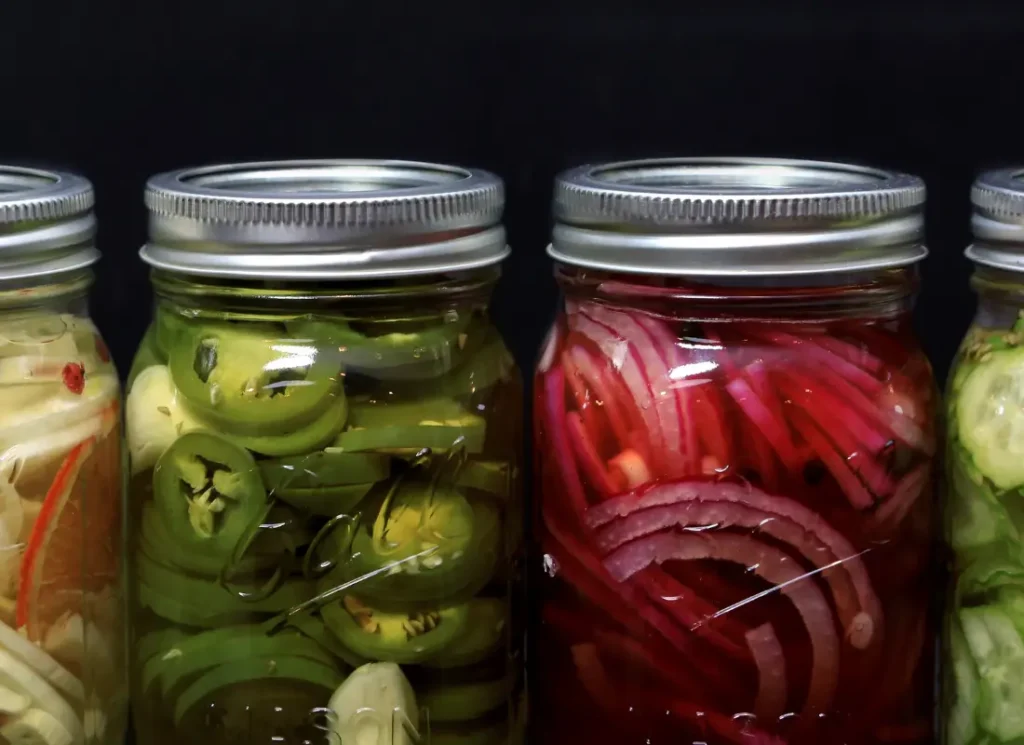Origin: Eastern Europe
Type: Side
Main Flavours: Vinegar
About Pickled Vegetables
Pickled Vegetables are vegetables that have been preserved in vinegar, usually alongside water, salt, and sometimes spices to give them extra flavour. This process gives them a tangy (vinegary, obviously!) taste that changes based on the vegetables used and how long the mixture is left to pickle for. The length of time the vegetables pickle also dictates whether the vegetables come out crunchy or soft.
Pickled vegetables are often eaten alone as a snack, added to sandwiches, salads or burgers, or used as a side dish to a main meal. Pickling extends to shelf life of vegetables considerably, so it’s a great way to store food that you’re not going to use up.
What Zsófi Says About Pickled Vegetables:
There is no other food as worthy as pickles – as strange as it may sound – to feature in my article about Eastern European food. There are a variety of vegetables that fall victim to the pickling process, cauliflower, carrots, beets, cabbage, and gherkin. For some of these, Eastern Europeans also use the classic vinegar to aid the pickling process, but for gherkins, the steps and ingredients are a little bit different.
You take a huge glass jar that you fill with gherkins, dill, garlic, and perhaps some spices such as mustard seeds, although this last is not a must. What really is essential, however, is covering the gherkins and seasonings with sourdough bread soaked in some salty water. This may seem strange but the yeast of the bread helps the fermentation process and gives these pickles their signature taste. After you’ve assembled your pickly goody jar, close it shut, and put it out in the sun in your garden until it looks completely fermented and ready.
Pickled cabbage, or sauerkraut, is another absolute favourite. The tradition of fermenting white cabbage in a vinegar, salt, and caraway seeds mixture is popular across the globe, the name itself being of a German origin. In many regions, it is almost a second side dish, consumed in pairs with your main dish. This is also very common in Eastern Europe, alongside using sauerkraut as an ingredient in traditional recipes (see pierogi and Stuffed Cabbage Rolls above as an example).
Pickled Vegetables Recipe
Pickled Vegetables Ingredients
2-3 cups of your choice of vegetables (suggestions include but are not limited to: cucumbers, carrots, cauliflower, onions)
2 cups of water
2 cups of white vinegar or apple cider vinegar
2 tablespoons of salt
1-2 tablespoons of sugar (optional)
Spices of your choice (optional – suggestions include mustard seeds, peppercorns, garlic cloves, dill, chilli flakes)
You will also need: a large, sterilised jar, or several smaller sterilised jars, big enough to pack in your chosen vegetables.
Pickled Vegetables Instructions
Thoroughly wash and chop your vegetables into bite-sized pieces or slices. Larger pieces will take longer to pickle and go soft in your jar, whereas smaller pieces will pickle more quickly.
In a saucepan, combine the water, vinegar, salt and sugar (if using). Bring the mixture to a boil and stir until all of the salt and sugar have completely dissolved.
Take your sterilised jar(s) and put any chosen spices at the bottom. Then tightly pack your vegetables into the jar(s), leaving a small amount of space for the liquid to fit between the gaps.
Carefully pour the hot brine over the vegetables into the jar(s), making sure to cover the vegetables completely. Leave at least 1 cm of space at the top of each jar.
Leave the brine to cool to lukewarm before you put the lid(s) back on the jar(s). If you put the lids on when the liquid is still hot, this could create pressure inside the jar which can affect the seal and therefore spoil your pickle!
Gently tap the jar(s) on the counter to release any bubbles that could be stuck.
Allow the jars to cool completely before storing them in the fridge. You can eat the pickles after a few hours, but their flavour will continue to develop over the next few weeks. Leave them the longer the better!

